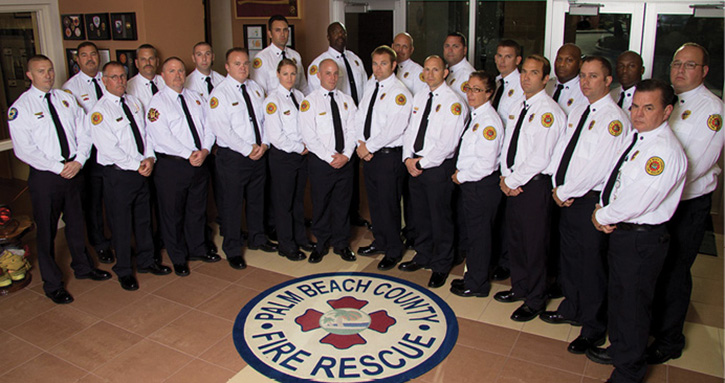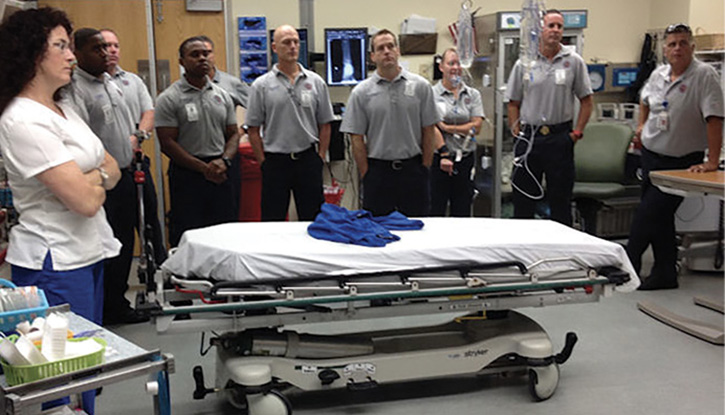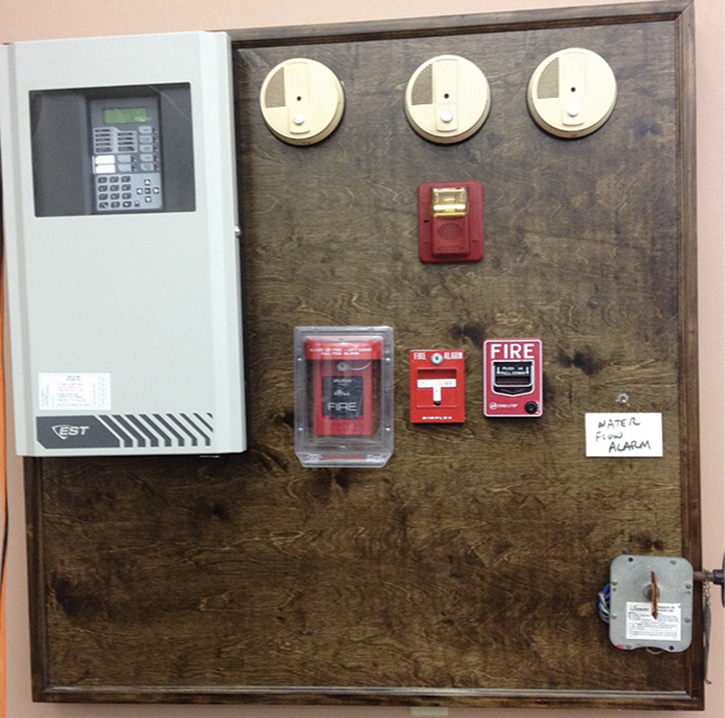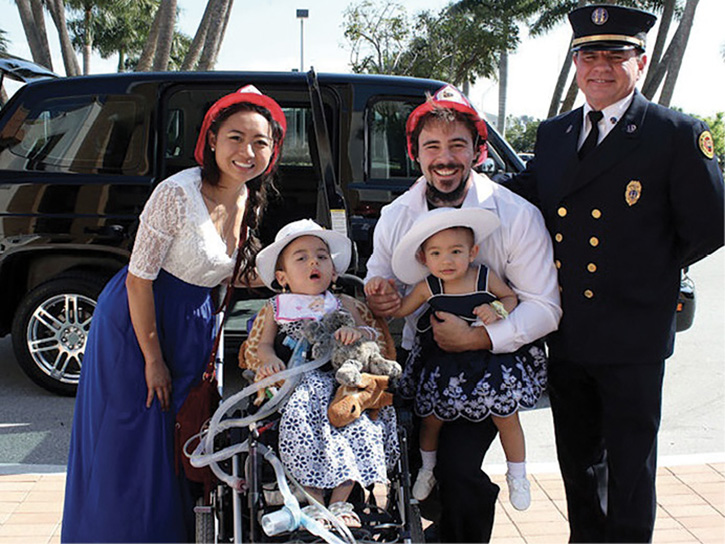
Scenario: You’ve just been given the responsibility—but few assets—to provide the necessary training to all the new officers (and some of the old “salty” ones) in your department. A quick look around tells you that your department doesn’t want to spend much money on this endeavor. If this sounds familiar, you are not alone.
I have been an engine company officer since 2002. During that time, almost every shift has been in busy stations that don’t have a Starbucks in their zone, and the Narcan never expires. Like most, there comes a point in your career when you feel obligated to pass on some of what you have learned about the job, leadership, people, and yourself.
RELATED FIREFIGHTER TRAINING
The Need for Company Officer Development
Officer Development: Leaders Teach
The Need for Realistic, Continuous Officer Development Training
Several years ago, I applied for and was selected to become a staff officer at our Training Division headquarters; my official title was “officer development coordinator.” For almost three years, my primary responsibility was five officer development academies (ODAs), which are two-week/80-hour academies for newly promoted lieutenants, fire captains, emergency medical services captains, and battalion chiefs; we also ran several ODAs for our reserve battalion. This academy was 32 hours long and was delivered in four eight-hour days on Saturdays. During that time, there were more than 200 graduates of the program. I attended three leadership academies while in the military, and I’ve benefited from that experience as well.

(1) Newly promoted officers on a field trip to our local trauma center, where they met with doctors and nurses. Here, everyone developed a better understanding of what’s expected of them. (Photos by author.)
Educational Tips
Here in south Florida, we have been successful for many years and developed a quality program. I’ve learned that you don’t have to spend much money to build a good program; you can deliver effective and practical training on a shoestring budget. You do, however, need commitment—your personal commitment and your organization’s commitment.

(2) A regional captain’s ODA class picture. Several area fire departments are represented in each class.

(3) We built a fully functioning alarm system training unit complete with a working panel, four smoke detectors, three pull stations, a water flow alarm, and a working valve alarm. It was cheap, and the only thing we had to buy was the wood mount. A local alarm company did the wiring and testing for us.
Following are some points of learning that you can apply to your department:
- This is “adult” firefighter education. There can be only one goal: deliver valuable training directly related to the job that is timely and relevant. No “fluff”!
- Every fire department is different—different staffing, different equipment, different geography, and different weather.
- Every firefighter is different—with a different past, from different generations, and with different skills.
- Every fire department is the same. This includes limited resources, limited space, limited time, and limited money.
- Every firefighter is the same. Basically, they will all respond the same to good leadership, good training, and mutual respect.
- Much like being in operations, your success or failure does not rest on one single act or decision. It is rooted in 100 “little” things that you do, that you create, and that you follow up on. So, pay attention to detail.
- Class layout and design. Put all the desks/tables in a U shape. No one wants to look at the back of someone’s head while they are talking. It also encourages participation and discussion, which are the keys to learning. No one can hide in the back. The U shape also creates a sense of team building and encourages participation. If possible, keep the class size to more than 12 and fewer than 25 students; this seems to be the best size for interaction. It can be done with as few as four students. In the past, we’ve have had classes of 26 students.
- Invite other agencies to attend. This is huge. If possible, reserve a few seats for other area departments. Don’t charge them anything; who can say NO to free training? The value of long-term networking, communication, and cooperation is priceless. Besides, this will put you in a better position to ask them for resources for this and other projects. Everybody wins!
- Invite/schedule on-duty units and off-duty personnel to attend lectures or training that won’t take away from the students. Do you have an impressive leadership presentation scheduled? Pack the house!
- Select a class leader and company leaders. Each class has a class leader and is divided into companies with a company leader. I select the least experienced person in the group as class leader. The same goes for company leaders. There is no better practice than being responsible for your peers. One of the first class leaders I selected was recently promoted and in an ODA just three days later. She grew into the role quickly. In the year that followed, she was placed in some difficult situations on some challenging calls, and she performed exceptionally well each time. I like to think that, in some small way, her experience as a class leader helped her grow into the new rank faster.
- Get continuing education units (CEUs) for your training. We worked with the state and received up to 60 hours of CEUs for the training. Most agencies will require you to get approval before the start of the class, so plan early. Ensure that you record all training and apply it to your Insurance Services Office rating.
- Give student handouts, binders, and other materials. Have each student receive a class binder with all the slide presentations and additional resources from the class. The intent of the binder is to help students follow along and use it as a reference for their first year or so after promotion.
- Carefully select the message; then select the messenger. Include well-respected officers from inside your department and from your area. I am lucky in this respect. Pool your resources with other area departments. For instance, south Florida is home to many well-respected fire officers and instructors such as Dave Downey, Bill Gustin, Mike Posner, and Robert Carpenter, who were very willing to help with our ODAs and have provided excellent blocks of instruction to our academy students. Rick Caldwell, with “R Cultures,” delivers an excellent block of instruction on sexual harassment/diversity training. Also, be ready for some “quid pro quo” by teaching something of value to their departments when they need resources. What they say about “experts” is true: you must have a tie and a briefcase and be from more than 50 miles away.
- Consider a panel discussion. Conference Director Bobby Halton’s “Unplugged” talk at FDIC International comes to mind here. The panel can be made up of current officers who will share their experiences. We have also had panels on firefighter behavioral health. Our panel usually consists of our employee assistance program coordinator, area clinicians, a chaplain, the peer support coordinator, and the critical incident stress management coordinator.
- Consider other sources of subject matter experts (SMEs). They can be law enforcement, government and union attorneys, hospitals, and so on. Once, a lineman from our local power company delivered a terrific class on street-level understanding of the power grid and how to stay safe. Many of these SMEs will do these presentations for little or no money.
- It must be as interactive and challenging as possible. A vivid, dramatic, or exciting learning experience teaches more than a routine or boring experience. (No slide presentations, please!) Students will learn more from participation, even during lectures. Demonstrations, role playing, skits, and training models do much to intensify the learning experiences of students.
- Create an environment of an expectation of success vs. an expectation of failure. This should be a very positive and confidence-building experience with no “training scars.”
- Failure is an option in training. Allow students to try new things, make decisions, and grow.
Class Projects
Another aspect of our classes that worked for us was student projects. We developed five easy, cheap, and worthwhile projects. Their focuses, guidelines, and structures follow.
- National Institute for Occupational Safety and Health (NIOSH) Line-of-Duty Death (LODD) Reports:
- This is a group project.
- Each company will present a NIOSH LODD report to the class.
- The lead instructor will choose the specific LODD report. Companies can swap or choose LODD reports.
- Address key points such as personal protective equipment; events leading to the LODD; the nature of the incident; the structures involved; the weather; the fire behavior; and, most importantly, the recommendations for avoiding future LODDs.
- Presentation time: approximately 30 minutes.
- Consult the NIOSH LODD Web site: http://www.cdc.gov/niosh/fire.
- Book reports:
- “Leaders are readers.”
- This is an individual project.
- Each student will select and read a book from an approved list and then present it to the class.
- Presentations are unscheduled and done throughout the class. This helps fill open blocks in the schedule.
- Outline key points of interest.
- Presentation time: approximately 10 minutes.
- The book reports are done informally when time permits.
- Student-designed multicompany drills:
- Our job is to run calls and train to run calls. So, train new officers in setting up drills and training.
- Each company will design, coordinate logistics, provide instruction for, and oversee the successful execution of some type of all-hazards, multicompany training.
- Training may include classroom instruction, skill stations, and a hands-on training portion outside in the training areas (burn building, smoke tower, and so on).
- Students will receive a “drill design” block of instruction before setting up their drill.
- “Instructor students” will do the appropriate paperwork, make the necessary contacts, and handle all logistics.
- Local drama clubs are used to supply actors for scenarios.
- Student research projects.
- These are group projects. Each company will research its assigned project and present its findings to the rest of the class. Use this to examine real problems facing your department and present these findings to your department’s executive staff at a later date.
- Typical topics include evaluating the behavioral health program and possible options, evaluating the hiring process for new firefighters, exploring the next generation of thermal imaging technologies, and how to best use the equipment.
- Presentation time: approximately 30 to 60 minutes.
- Students are encouraged to use SMEs as consultants or speakers and any other resources available.
- Community involvement through ODA community projects:
- Let the class decide on the recipient. Give only suggestions, ideas, and guidance. This project must directly benefit a deserving person or group. Encourage it to be local.
- Fundraisers are often used in the form of raffles, challenge coin and coffee mug sales, lunches at headquarters, soliciting donors in the community, and so on.
- Involve as many others as possible such as the union, administration, public information officers, other classes, the International Association of Fire Fighters, local businesses, charities, and so on.
- Insist that if you start it, finish it. Understand momentum, human nature, and short attention spans.
- This can generate very positive publicity for your department. Push it out to the media, if appropriate.
In addition, require every class to coordinate its own class picture and make a plaque to hang at the training facility. If you go to the military’s Explosive Ordnance Disposal School at Eglin Air Force Base, you will see class pictures on the walls dating back to the school’s beginnings in World War II. It is amazing how quickly time passes and how people move on in their careers and retire. A class picture is a nice way to honor the past.

(4) One of our best ODA community service projects was Bella’s Ride. Two ODA classes teamed up and bought a brand-new wheelchair van for a local family with a special needs daughter. These projects have changed lives.
Finally, build flexibility into your program. Life happens to everyone. “Semper Gumbie”— “Always Flexible”—should be your motto, so have several backup plans, drills, and presentations you can put together quickly if an instructor doesn’t show up or some other problem arises at the last minute.
Base the success of your program on the “little things” you do. Pay attention to detail. Show enthusiasm; it will be contagious. Also, be present—half of life is showing up. This is the best job in the world, the best job I’ve ever had. Why wouldn’t you and your brothers and sisters want to be good at it?
References
1. Palm Beach County Fire Rescue: The Hot Zone September 2015 Program. https://youtu.be/6ULNDc6dQ0E.
2. Palm Beach County Fire Rescue: Bella’s Ride. https://youtu.be/5pg-o0bnXhs.
3. Palm Beach County Fire Rescue: Captain Officer Development Academy Class #38. https://youtu.be/dibXfedejMQ.
LAWRENCE DOELLING is a 28-year fire service veteran and a captain with Palm Beach County (FL) Fire Rescue. For nearly three years, he served in the department’s Training Division, developing and overseeing five Office Development Academies. He has an associate and a bachelor’s degree and is pursuing a master’s degree in social work. Doelling has also been the coordinator for the area CISM team for five years and has served as an noncommissioned officer in the U.S. Army and U.S. Air Force.

